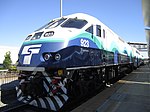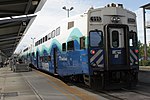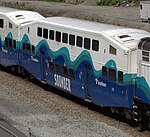Sounder commuter rail
| Sounder | |||||||||||||||||||||||||||||||||||||||||||||||||||||||||||||||||||||||||||||||||||||||||||||||||||||||||||||||||||||||||||||||||||||||||||||||||||||||||||||||||||||||||||||||||||||||
|---|---|---|---|---|---|---|---|---|---|---|---|---|---|---|---|---|---|---|---|---|---|---|---|---|---|---|---|---|---|---|---|---|---|---|---|---|---|---|---|---|---|---|---|---|---|---|---|---|---|---|---|---|---|---|---|---|---|---|---|---|---|---|---|---|---|---|---|---|---|---|---|---|---|---|---|---|---|---|---|---|---|---|---|---|---|---|---|---|---|---|---|---|---|---|---|---|---|---|---|---|---|---|---|---|---|---|---|---|---|---|---|---|---|---|---|---|---|---|---|---|---|---|---|---|---|---|---|---|---|---|---|---|---|---|---|---|---|---|---|---|---|---|---|---|---|---|---|---|---|---|---|---|---|---|---|---|---|---|---|---|---|---|---|---|---|---|---|---|---|---|---|---|---|---|---|---|---|---|---|---|---|---|---|
 Two Sounder trainsets at Tukwila station | |||||||||||||||||||||||||||||||||||||||||||||||||||||||||||||||||||||||||||||||||||||||||||||||||||||||||||||||||||||||||||||||||||||||||||||||||||||||||||||||||||||||||||||||||||||||
| Overview | |||||||||||||||||||||||||||||||||||||||||||||||||||||||||||||||||||||||||||||||||||||||||||||||||||||||||||||||||||||||||||||||||||||||||||||||||||||||||||||||||||||||||||||||||||||||
| Owner | Sound Transit | ||||||||||||||||||||||||||||||||||||||||||||||||||||||||||||||||||||||||||||||||||||||||||||||||||||||||||||||||||||||||||||||||||||||||||||||||||||||||||||||||||||||||||||||||||||||
| Locale | Seattle metropolitan area | ||||||||||||||||||||||||||||||||||||||||||||||||||||||||||||||||||||||||||||||||||||||||||||||||||||||||||||||||||||||||||||||||||||||||||||||||||||||||||||||||||||||||||||||||||||||
| Transit type | Commuter rail | ||||||||||||||||||||||||||||||||||||||||||||||||||||||||||||||||||||||||||||||||||||||||||||||||||||||||||||||||||||||||||||||||||||||||||||||||||||||||||||||||||||||||||||||||||||||
| Number of lines | 2 | ||||||||||||||||||||||||||||||||||||||||||||||||||||||||||||||||||||||||||||||||||||||||||||||||||||||||||||||||||||||||||||||||||||||||||||||||||||||||||||||||||||||||||||||||||||||
| Number of stations | 12 | ||||||||||||||||||||||||||||||||||||||||||||||||||||||||||||||||||||||||||||||||||||||||||||||||||||||||||||||||||||||||||||||||||||||||||||||||||||||||||||||||||||||||||||||||||||||
| Daily ridership | 7,300 (weekdays, Q3 2024)[1] | ||||||||||||||||||||||||||||||||||||||||||||||||||||||||||||||||||||||||||||||||||||||||||||||||||||||||||||||||||||||||||||||||||||||||||||||||||||||||||||||||||||||||||||||||||||||
| Annual ridership | 1,630,000 (2023)[2] | ||||||||||||||||||||||||||||||||||||||||||||||||||||||||||||||||||||||||||||||||||||||||||||||||||||||||||||||||||||||||||||||||||||||||||||||||||||||||||||||||||||||||||||||||||||||
| Website | Sounder Rider Guide | ||||||||||||||||||||||||||||||||||||||||||||||||||||||||||||||||||||||||||||||||||||||||||||||||||||||||||||||||||||||||||||||||||||||||||||||||||||||||||||||||||||||||||||||||||||||
| Operation | |||||||||||||||||||||||||||||||||||||||||||||||||||||||||||||||||||||||||||||||||||||||||||||||||||||||||||||||||||||||||||||||||||||||||||||||||||||||||||||||||||||||||||||||||||||||
| Began operation | September 18, 2000 (S Line) December 26, 2003 (N Line) | ||||||||||||||||||||||||||||||||||||||||||||||||||||||||||||||||||||||||||||||||||||||||||||||||||||||||||||||||||||||||||||||||||||||||||||||||||||||||||||||||||||||||||||||||||||||
| Operator(s) | BNSF | ||||||||||||||||||||||||||||||||||||||||||||||||||||||||||||||||||||||||||||||||||||||||||||||||||||||||||||||||||||||||||||||||||||||||||||||||||||||||||||||||||||||||||||||||||||||
| Reporting marks | SDRX | ||||||||||||||||||||||||||||||||||||||||||||||||||||||||||||||||||||||||||||||||||||||||||||||||||||||||||||||||||||||||||||||||||||||||||||||||||||||||||||||||||||||||||||||||||||||
| Number of vehicles | 14 locomotives 67 passenger cars[3] | ||||||||||||||||||||||||||||||||||||||||||||||||||||||||||||||||||||||||||||||||||||||||||||||||||||||||||||||||||||||||||||||||||||||||||||||||||||||||||||||||||||||||||||||||||||||
| Train length | 2–7 passenger cars | ||||||||||||||||||||||||||||||||||||||||||||||||||||||||||||||||||||||||||||||||||||||||||||||||||||||||||||||||||||||||||||||||||||||||||||||||||||||||||||||||||||||||||||||||||||||
| Headway | N Line: 4 round trips per day S Line: 10 round trips per day | ||||||||||||||||||||||||||||||||||||||||||||||||||||||||||||||||||||||||||||||||||||||||||||||||||||||||||||||||||||||||||||||||||||||||||||||||||||||||||||||||||||||||||||||||||||||
| Technical | |||||||||||||||||||||||||||||||||||||||||||||||||||||||||||||||||||||||||||||||||||||||||||||||||||||||||||||||||||||||||||||||||||||||||||||||||||||||||||||||||||||||||||||||||||||||
| System length | 81.8 mi (131.6 km)[3] | ||||||||||||||||||||||||||||||||||||||||||||||||||||||||||||||||||||||||||||||||||||||||||||||||||||||||||||||||||||||||||||||||||||||||||||||||||||||||||||||||||||||||||||||||||||||
| Track gauge | 4 ft 8+1⁄2 in (1,435 mm) standard gauge | ||||||||||||||||||||||||||||||||||||||||||||||||||||||||||||||||||||||||||||||||||||||||||||||||||||||||||||||||||||||||||||||||||||||||||||||||||||||||||||||||||||||||||||||||||||||
| Top speed | 79 mph (127 km/h) | ||||||||||||||||||||||||||||||||||||||||||||||||||||||||||||||||||||||||||||||||||||||||||||||||||||||||||||||||||||||||||||||||||||||||||||||||||||||||||||||||||||||||||||||||||||||
| |||||||||||||||||||||||||||||||||||||||||||||||||||||||||||||||||||||||||||||||||||||||||||||||||||||||||||||||||||||||||||||||||||||||||||||||||||||||||||||||||||||||||||||||||||||||
Sounder commuter rail (reporting mark SDRX) is a commuter rail service operated by BNSF on behalf of Sound Transit.[4] Service operates Monday through Friday during peak hours from Seattle, Washington, north to Everett and south to Lakewood. In 2023, the system had a ridership of 1,630,000, or about 7,300 per weekday as of the third quarter of 2024.
As of 2017[update], schedules serve the traditional peak commutes, with most trains running inbound to Seattle in the morning and outbound in the afternoon. Three daily round-trips run the reverse commute to and from Tacoma.[5] Additional Sounder trains operate on some Saturdays and Sundays for travel to and from Seahawks and Sounders games at Lumen Field and Mariners games at T-Mobile Park. Both stadiums are a short walk from King Street Station.
Service history
[edit]S Line
[edit]The S Line (formerly the South Line) began service with two round trip trains on September 18, 2000, with stops in Tacoma, Sumner and Auburn that terminated in Seattle. Puyallup and Kent stations were added February 5, 2001, with Tukwila being added March 12, 2001. There are currently thirteen round trips on the S Line, with three operating in the reverse commute direction.[5]
In July 2010, Sound Transit reached a new agreement with BNSF, valued at $185 million, which grants Sound Transit permanent access to the S Line corridor, as well as allowing four more daily round trips to begin, starting in 2012 and continuing through 2016.[6]
On October 8, 2012, the extension to South Tacoma and Lakewood stations was inaugurated, with five daily round trips, all of which are in the peak direction, serving the new stations.[7] In September 2016, a mid-day round trip was added between Lakewood and Seattle.[8] In September 2017, two additional round trips were added, bringing the total to eight daily round trips servicing the Lakewood extension.[9][5]
The average weekday ridership in 2010 on the S Line was 8,300, down 7% from 2009 due to continued low employment in Downtown Seattle. Since then the average ridership has increased and as of October 2015 stood at 14,500 per day.[10] In 2019, S Line ridership was 16,419 per day.[11]
N Line
[edit]In May 2003, Sound Transit agreed to a $250 million lease arrangement with BNSF to use its Everett-to-Seattle tracks for 100 years. On December 17, 2003, the Sound Transit board approved a modified agreement that gave it a perpetual right to use the Everett-Seattle tracks for $258 million.[12]
The 35-mile (56 km) Everett-to-Seattle N line (formerly North Line) started with a Seahawks game train on December 21, 2003. Regular service started on December 22 with one morning train to Seattle and one evening train back. A second round trip train was added on June 6, 2005, to help increase ridership, a third was added in September 2007. In September 2008, an additional train was added to the line, bringing the total number to four round trips in the peak direction. On May 31, 2008, service to Mukilteo station began. There are currently three stops along the N Line: Edmonds, Mukilteo, and Everett.[13][14]
Additionally, Sound Transit partners with Amtrak Cascades to allow Sounder riders to use the two trains per day that Amtrak Cascades operates to Bellingham, WA and Vancouver, BC through the RailPlus program. This allows commuters to use the Sounder fare structure between Everett and Seattle. The program is available only to riders who use monthly passes. The Amtrak Cascades trains do not stop at Mukilteo nor does Amtrak's Empire Builder from Chicago, Illinois.
Weekday ridership on the N Line was roughly 1,100 in 2010[15] and was about 1,561 in the first quarter of 2016.[16] Trains on the N Line have been prone to frequent cancellation due to mudslides throughout its history,[17] though WSDOT has[when?] begun construction to remedy the problem.[18]
Future expansion
[edit]
Sound Transit plans to add additional S Line stations at Tillicum and DuPont. The track has already been constructed by Sound Transit with funding from WSDOT as part of the Point Defiance Bypass project. Funding for constructing the two stations was approved in the 2016 Sound Transit 3 ballot measure and is expected to cost $300 million. It was originally scheduled to open in 2036, but was delayed to 2045 due to a systemwide funding gap caused by increased planning costs.[19][20] The Tillicum station is planned to be located near the intersection of Interstate 5 and Berkeley Street Southwest, adjacent to Joint Base Lewis–McChord. The terminus at DuPont station is planned to be located adjacent to an existing park and ride lot at Interstate 5 and Center Drive.[21]
In addition, Sound Transit plans to extend station platform lengths on the S Line to accommodate trains up to ten cars in length, up from the current seven, and increase service.[22] Both programs were included in the Sound Transit 3 ballot measure and were originally scheduled to be fully completed by 2036, but were also delayed by the systemwide funding gap and subsequent realignment of projects. Platform extensions are scheduled to be complete by 2036, while additional trips on the S Line are scheduled to be implemented by 2046.[23][24]
Fares
[edit]Sounder operates using a proof-of-payment fare system and uses distance-based fares; adult fares range from $3.25 to $5.75.[3] Passengers are required to purchase a paper ticket, use a mobile ticket, or tap their ORCA card (and receive a valid permit to travel) before boarding trains. Sound Transit fare inspectors or police officers randomly board trains and check for valid proof-of-payment, issuing warnings or fines to passengers without valid proof-of-payment. Passengers using ORCA cards are charged the maximum fare from the station they are traveling from and are issued a permit to travel when they tap before boarding and, if necessary, receive a refund when they tap after boarding. Discounted fares are offered for seniors and the disabled, and low-income riders qualifying for the ORCA Lift program. Youth ride the sounder for free/[25]
During the COVID-19 pandemic in 2020, fare collection for all Sound Transit services was suspended from March 21 to June 1.[26] Fares on Link and Sounder were reintroduced on June 1 with a discounted rate of $2 for non-ORCA users on Sounder.[27]
Ridership statistics
[edit]| Year | Ridership | YoY Diff. % |
|---|---|---|
| 2004 | 955,298 | — |
| 2005 | 1,268,291 | 32.8% |
| 2006 | 1,692,971 | 33.5% |
| 2007 | 2,156,652 | 27.4% |
| 2008 | 2,668,623 | 23.7% |
| 2009 | 2,492,362 | -6.6% |
| 2010 | 2,364,290 | -5.1% |
| 2011 | 2,543,955 | 7.6% |
| 2012 | 2,811,891 | 10.5% |
| 2013 | 3,035,735 | 8% |
| 2014 | 3,361,317 | 10.7% |
| 2015 | 3,812,040 | 13.4% |
| 2016 | 4,165,992 | 9.3% |
| 2017[28] | 4,438,374 | 6.5% |
| 2018[29] | 4,646,408 | 4.7% |
| 2019[30] | 4,616,656 | -0.6% |
| 2020[31] | 1,274,219 | -72.4% |
| 2021[32] | 711,720 | -44.1% |
| 2022[32] | 1,140,908 | 60.3% |
| Data from Sound Transit[33] | ||
Graphs are unavailable due to technical issues. Updates on reimplementing the Graph extension, which will be known as the Chart extension, can be found on Phabricator and on MediaWiki.org. |
Rolling stock
[edit]| Model | Manufactured | Road Numbers | Number In Fleet | Notes | Image |
|---|---|---|---|---|---|
| Locomotives | |||||
| EMD F59PHI | 1999 | 901–904 | 4 | All locomotives rebuilt with engines that meet the Tier 3 EPA standard to reduce emissions and provide fuel savings.[34] | 
|
| 2000 | 905–906 | 2 | |||
| 2001 | 907–911 | 5 | |||
| MotivePower MP40PH-3C | 2012 | 921–923 | 3 | Upgraded to comply with the Tier 3 emissions standard | 
|
| Cab Cars | |||||
| Bombardier BiLevel cab car | 1999 | 101–104 | 4 | 
| |
| 2000 | 105–111 | 7 | 112–118 sold to Caltrain.[35] | ||
| 2003 | 301–307 | 7 | |||
| 2017 | 321–329 | 9 | 
| ||
| 2022 | 330–332 | 3 | [36] | ||
| Coaches | |||||
| Bombardier BiLevel Coach | 2000 | 201–213 | 13 | 
| |
| 2001 | 214–215 | 2 | |||
| 2002 | 216–218, 227–228, 231–240 | 15 | 219–226 & 229–230 sold to Caltrain.[35] | ||
| 2003 | 401–410 | 10 | |||
| 2022 | 411-418 | 8 | |||
| Sources (unless noted otherwise):[37][38] | |||||
References
[edit]- ^ "Transit Ridership Report Third Quarter 2024" (PDF). American Public Transportation Association. November 20, 2024. Retrieved November 23, 2024.
- ^ "Transit Ridership Report Fourth Quarter 2023" (PDF). American Public Transportation Association. March 4, 2024. Retrieved September 5, 2024.
- ^ a b c "Transit Development Plan 2022–2027 and 2021 Annual Report" (PDF). Sound Transit. August 25, 2022. pp. 12–14. Retrieved November 17, 2022.
- ^ "Sounder Commuter Rail Train Specifications". Sound Transit. July 18, 2009. Archived from the original on August 2, 2009. Retrieved February 10, 2008.
- ^ a b c "Sound Transit: Sounder Commuter Rail Schedules". Sound Transit. Retrieved April 6, 2017.
- ^ "Sound Transit inks BNSF pact to add Sounder trains, picks preferred East Link route alternative". Progressive Railroading magazine. July 26, 2010. Retrieved December 23, 2023.
- ^ Hall, C.B. (November 21, 2012). "Sounder train gets a lackluster start in Lakewood". Crosscut. Retrieved May 2, 2017.
- ^ "South Sounder line to start mid-day service in September". Seattle Times. August 30, 2016. Retrieved April 6, 2017.
- ^ "Sounder south gets better than ever with new trips starting 9/25". Sound Transit. August 24, 2017. Archived from the original on June 12, 2018. Retrieved December 8, 2017.
- ^ "October 2015 Ridership Summary" (PDF). www.soundtransit.org. Archived from the original (PDF) on November 7, 2013. Retrieved November 27, 2013.
- ^ "Q4 2019 Service Delivery Quarterly Performance Report" (PDF). Sound Transit. February 27, 2020. Retrieved July 30, 2020.
- ^ Velush, Lukas (December 17, 2003). "Sounder to finally get going". Everett Herald. Retrieved December 24, 2023.
- ^ Pesznecker, Scott (May 31, 2008). "Sounder begins service to Mukilteo today". Everett Herald. Everett Herald. Retrieved May 31, 2008.
- ^ "Mukilteo Station". Sound Transit. February 10, 2008. Archived from the original on February 7, 2008. Retrieved February 10, 2008.
- ^ 2011 SIP, page 26 Archived August 10, 2011, at the Wayback Machine
- ^ "2016 Q1 Report" (PDF). Archived from the original (PDF) on April 20, 2018. Retrieved April 20, 2018.
- ^ "Mudslides continue to plague rail traffic north of Seattle". Archived from the original on May 30, 2016. Retrieved November 27, 2013.
- ^ "Work starts on landslide solutions for Pacific Northwest Rail Corridor".
- ^ Lynn, Adam (March 24, 2016). "Several Pierce County projects in $50 billion Sound Transit plan". The News Tribune. Retrieved December 20, 2016.
- ^ Luczak, Marybeth (August 6, 2021). "Sound Transit Adopts 'Realignment' Plan". Railway Age. Retrieved August 15, 2021.
- ^ "Sounder Extension to DuPont" (PDF). Sound Transit. July 21, 2016. Retrieved January 5, 2018.
- ^ "South Sounder Capital Improvements Program" (PDF). Sound Transit. July 1, 2016. Retrieved April 6, 2017.
- ^ "Realigned Capital Program Pursuant to Sound Transit Board action of August 5, 2021" (PDF). Sound Transit. August 12, 2021. Retrieved August 15, 2021.
- ^ "Sounder South Capacity Expansion". Sound Transit. Retrieved August 15, 2021.
- ^ "Sounder train fares". Sound Transit. Retrieved December 21, 2018.
- ^ "Sound Transit to suspend fares on all transit modes until further notice" (Press release). Sound Transit. March 20, 2020. Retrieved June 11, 2020.
- ^ "Reduced fare options will accompany June 1 reintroduction of fares on Link and Sounder" (Press release). Sound Transit. May 18, 2020. Retrieved June 11, 2020.
- ^ "2017 Ridership".
- ^ https://www.soundtransit.org/sites/default/files/documents/monthly-service-performance-report-201812.pdf [bare URL PDF]
- ^ https://www.apta.com/wp-content/uploads/2019-Q4-Ridership-APTA.pdf&ved=2ahUKEwivjujLs8bpAhXGr54KHfL8DH4QFjAEegQIBBAK&usg=AOvVaw2Uwd3rFLsZ9LeH_rk_7YT0 [dead link]
- ^ "Q4 2020 Service Delivery Quarterly Performance Report" (PDF). Sound Transit. February 25, 2021. Retrieved March 4, 2021.
- ^ a b "Ridership". System performance tracker. Sound Transit. Retrieved October 16, 2023.
- ^ "Quarterly Ridership Report archive". Sound Transit. Retrieved April 12, 2017.
- ^ "MOTION NO. M2016-123 Sounder Locomotive Overhaul Contract Amendment" (PDF). Sound Transit. December 15, 2016. Archived from the original (PDF) on February 26, 2017. Retrieved February 25, 2017.
- ^ a b "Sound Transit Motion No. M2001-72". Sound Transit. Archived from the original (PDF) on June 20, 2010.
- ^ "New Sounder Train Cars Arrive In Seattle". Seattle, WA Patch. August 22, 2022. Retrieved October 15, 2022.
- ^ "Draft 2015 Service Implementation Plan – Appendix B: Fleet Plans" (PDF). Sound Transit. p. 112. Archived from the original (PDF) on November 8, 2014. Retrieved November 8, 2014.
- ^ "Two new Sounder train cars arrive for Seattle-Lakewood line". August 23, 2022.
External links
[edit]- Sounder commuter rail
- Sound Transit
- Transportation in Seattle
- Transportation in King County, Washington
- Transportation in Snohomish County, Washington
- Transportation in Pierce County, Washington
- Commuter rail in the United States
- Passenger rail transportation in Washington (state)
- BNSF Railway lines
- Railway services introduced in 2003
- Railway services introduced in 2000
- American companies established in 2003
- American companies established in 2000
- 2003 establishments in Washington (state)
- 2000 establishments in Washington (state)


